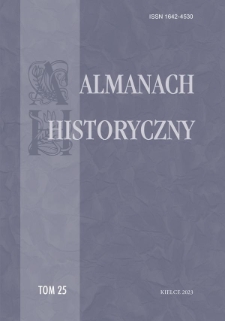Biblioteka Cyfrowa Uniwersytetu Jana Kochanowskiego udostępnia 13 083 obiektów cyfrowych
Obiekt
Tytuł: The Founding Myth of the Kyiv Pechersk Lavra in the Lightof the Tradition of the The Paterik of the Kievan Caves Monastery
Twórca:
Tytuł publikacji grupowej:
Współtwórca:
Abstrakt:
The article deals with the founding myth of the Pechersk Lavra as it is preserved in the Kiev- Pechersk Paterik, one of the most important sources for understanding the history of the monastic movement in the Ruthenian lands. The article focuses on the problem of the creation of the founding myth and its function in the construction of a specific message about the Pechersk Lavra. By studying the texts of the Paterik and comparing them with the founding myths known from the European area, I have speculated that an integral part of the original story of the beginnings of the above-mentioned monastery was the legend of the relics it could boast of: the golden belt and the crown of Simon the Varangian. This legend, found in the Life of Anthony, became the nucleus of the later myth of the initium loci, which linked the origins of the monastery to the “Varangian thread”. The complex history of the Pechersk Lavra, full of dramatic twists and turns, resulted in a significant transformation of the founding myth. The place of the founder of the monastic community, Anthony, was taken by the second Pechersk Ihumen, Theodosius, with whose work the later authors of the Paterik and The Rus’ chronicles accounts linked most of the stories about the beginnings of the monastery, which they knew from the Life of Anthony and the monastic histories.
Spis treści:
Spis treści
Artykuły
11 Anna Tatarkiewicz (Uniwersytet im. Adama Mickiewicza w Poznaniu), About the Troubles of Roman Men Conceiving a Descendant. Male Fertility Disorders in Ancient Rome
25 Katarzyna Maria Dźwigała (Uniwersytet Kardynała Stefana Wyszyńskiego w Warszawie), Religious Issues in the Speech in Honor of Constantine of 313 (Panegyric XII from the Collection of Panegyrici Latini)
37 Mariusz Bartnicki (Uniwersytet Marii Curie-Skłodowskiej w Lublinie), The Founding Myth of the Kyiv Pechersk Lavra in the Light of the Tradition of the The Paterik of the Kievan Caves Monastery
59 Kacper Górski (Uniwersytet Jagielloński w Krakowie), Starostwo stężyckie w drugiej połowie XVI wieku
83 Urszula Kicińska (Uniwersytet Komisji Edukacji Narodowej w Krakowie), Problems of Everyday Life at the Court of Konstancja Marianna née Potocka Szczukowa (d. 1733), Deputy-Chancelloress of Lithuania
113 Olimpia Skieterska (Uniwersytet w Białymstoku), Classification of Murders in 18th Century London Based on Old Bailey Proceedings
133 Rafał Dobek (Uniwersytet im. Adama Mickiewicza w Poznaniu), French Social and Political Caricature during the July Monarchy and the Second Republic (1830– 1851)
165 Przemysław Matusik (Uniwersytet im. Adama Mickiewicza w Poznaniu), Tajemnice obrazu Juliusa Knorra Poznański rynek w 1838 roku. Wokół ikonografii miejskiej XIX wieku
193 Eugeniusz Niebelski (Katolicki Uniwersytet Lubelski Jana Pawła II), Zesłaniec Adam Jastrzębski i jego wspomnienia o powstaniu nad Bajkałem 1866 roku
213 Artur Markowski (Uniwersytet Warszawski), Deaf People in the Kingdom of Poland, in Light of the 1897 Census
247 Oleg Mikhin (Rosyjski Państwowy Uniwersytet Humanistyczny w Moskwie), Иерар- хия самоидентификации высших офицеров польского происхождения в позд- ней Российской империи. (На материале биографий Б. Громбчевского, Ю. Дов- бор-Мусницкого и Я. Яцины)
269 Łukasz Janeczek (Uniwersytet Zielonogórski), Wytyczne dla komisji szacującej stan nieruchomości w ramach działalności Radomskiego Towarzystwa Kredytowego Miejskiego z 1900 roku
291 Paweł Pryt (Uniwersytet Jana Kochanowskiego w Kielcach), Aktywność polityczna, społeczno-gospodarcza właściciela ordynacji chroberskiej Aleksandra Erwina Wielopolskiego (1875–1937) – próba nakreślenia problematyki
307 Witold Jarno (Uniwersytet Łódzki), Tytularny generał dywizji Edward Hejdukiewicz (1868–1932). Zarys biografii
329 Karolina Trzeskowska-Kubasik (Biuro Badań Historycznych IPN (Centrala)), Działalność niemieckich obozów w latach 1939–1945 na terenie Kreishauptmannschaft Busko (dystrykt Radom)
361 Anita Młynarczyk-Tomczyk (Uniwersytet Jana Kochanowskiego w Kielcach), „Ku socjalistycznej Polsce”. Patos Polski Ludowej z perspektywy jej dwudziestolecia w filmach krótkometrażowych
401 Maria Pasztor (Uniwersytet Warszawski), The Oder–Neisse Border in Polish-Belgian Relations between 1956–1975
Artykuły recenzyjne i recenzje
427 Przemysław P. Szpaczyński (badacz niezależny, Zielona Góra), Spór o Stanisława Żółkiewskiego
451 Lori Ann Garner, Hybrid Healing. Old English Remedies and Medical Texts, Manchester University Press
2022 (Manchester Medieval Literature and Culture) – Sylwia Konarska-Zimnicka (Uniwersytet Jana Kochanowskiego w Kielcach)
457 Speculum arabicum. Intersecting Perspectives on Medieval Encyclopaedism. Proceedings of the International Conference at Louvain-la-Neuve and Cambron-Casteau, 22–24 May 2017, eds. Godefroid de Callataÿ, Mattia Cavagna, Baudouin Van den Abeele, Turnhout–Louvain-la-Neuve, Brepols–Centre d’études médiévales, 2023 (Textes, Études, Congrès, 33) – Sylwia Konarska-Zimnicka (Uniwersytet Jana Kochanowskiego w Kielcach)
463 Palące problemy, czyli w sprawie książki Andrzeja Pola O Piotrkowskiej Straży Pożarnej, Piotrków Trybunalski 2021 – Eryk Zywert (Uniwersytet Łódzki)
471 Jindřich Zdeněk Charouz, Zůstává mi však milost Boží. Život a internace biskupa- -vyznavače Josefa Karla Matochy (1888–1961), Karmelitánské nakladatelství, Praha 2022 – Ryszard Gryz (Uniwersytet Jana Kochanowskiego w Kielcach)
Kronika naukowa
483 Ten Years of the Thematic Competition for Students “Our Neighbours – Jews” – Agnieszka Dziarmaga (Muzeum Wsi Kieleckiej), Edyta Majcher-Ociesa (Uniwersytet Jana Kochanowskiego w Kielcach)
487 Dziesięć lat działalności Studenckiego Koła Naukowego „Judaica” – Michał Brzoza (Uniwersytet Jana Kochanowskiego w Kielcach)
493 Zasady przyjmowania tekstów do druku i procedury recenzowania obowiązujące w „Almanachu Historycznym”
Miejsce wydania:
Opis fizyczny:
ISSN:
Wydawca:
Wydawnictwo Uniwersytetu Jana Kochanowskiego w Kielcach
Data wydania:
Identyfikator:
oai:bibliotekacyfrowa.ujk.edu.pl:12689 doi:10.25951/11120
Język:
Jest częścią:
Ma część:
Typ:
Prawa dostępu:
Format:
Kolekcje, do których przypisany jest obiekt:
- Biblioteka Cyfrowa Uniwersytetu Jana Kochanowskiego > Wydawnictwo Uniwersyteckie
- Biblioteka Cyfrowa Uniwersytetu Jana Kochanowskiego > Wydawnictwo Uniwersyteckie > Wydawnictwa ciągłe
- Biblioteka Cyfrowa Uniwersytetu Jana Kochanowskiego > Wydawnictwo Uniwersyteckie > Wydawnictwa ciągłe > „Almanach Historyczny”
Data ostatniej modyfikacji:
3 kwi 2025
Data dodania obiektu:
3 kwi 2025
Liczba wyświetleń treści obiektu:
28
Wszystkie dostępne wersje tego obiektu:
https://bibliotekacyfrowa.ujk.edu.pl/publication/11120

